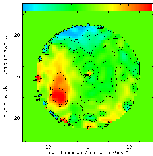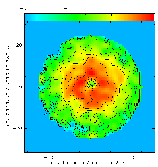Microwave Holography of Radioastronomical Antennas
Principles
The problem of measuring the surface accuracy of a large reflector
antenna is not simple. Usually it takes several days of painful
measurements, and requires that the receiver block be removed and
a particular instrument set (theodolite, metric gauges) placed in a
difficult-to-access location.
Using the Fourier relationship connecting the shape (and phase) of the
radiation pattern and the antenna illumination function, a measurement
of the former can be used to infer the latter. The phase of the antenna
illumination is proportionale to deformations of the reflector, and so
these can be measured.
The main problem is that, although measuring the amplitude of the
radiation pattern is simple, and can be done with the usual
radioastronomical receivers, phase measurement is difficult.
We have developed, in cooperation with IRAM and the University of
Napoli, a technique to infer the phase from two (or more) out-of-focus
measurements of the radiation pattern.
Results
We have performed three set of measures on the
CNR-IRA
32-m radio telescope
(image)
1988: Measurements using Misell phase retrieval algorithm, and the
22 GHz Orion water vapor maser as a reference source.
1990: Measurements using Misell phase retrieval algorithm, and
a geostationary TV broadcast satellite iat 12 GHz as a reference source.
1995: Measurements using a phase fitting algorithm and the
22 GHz W49N water vapor maser as a reference source.
 Phase image
Phase image
 Amplitude image
Amplitude image